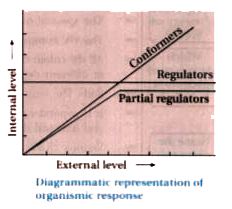How do organisms living in different habitat manage with stressful conditions ?
• During the course of millions of years of their existence, many organisms have evolved a relatively constant internal environment, which allows all the biochemical reactions to proceed with maximum efficiency.
• Their constant internal environment (maintained by homoestasis) could be in terms of optimal temperature, osmotic concentration of body muids etc.
• Other organisms cope with the situation by the following:
• (a) Regulation : Homeostasis is maintained in organisms by physiological and/ or behavioural means to ensure a constant body temperature (thermoregulation),osmotic concentration(osmoregulation) etc.
• (b) Conformation : A constant internal environment can not be maintained by most of the animals and nearly all plants.
• Their body temperature changes with the ambient temperature.
• There is change in osmotic concentration of body fluids of aquatic animals with ambient water or osmotic concentration.
• Thermoregulation is energetically expensive for many organisms particularly for small organisms like shrews and humming birds.
• Heat loss or heat gain is a function of surface area.
• Small animals have a larger suface area relative to their volume, they tend to lose body heat very fast when it is cold outside, then they have to expend much energy to generate body heat through metabolism.
• Because of this very small animal are rarely found in polar regions.
• (c) Migrate : The organisms can move away temporarily from the stressful habitat to a more hospitable area and return when stressful period is over.
• It is like man living in hot regions move to hill stations during summer.
• Many animals, particularly birds, during winter undertake long distance migrations to more hospitable areas.
• Every winter the famous Keolado National Park (Bharatpur)in Rajasthan host thousands of migratory birds coming from Siberia and other extremely cold northern regions.
• (d) Suspend : In bacteria, fungi and lower plants, various kinds of thick walled spores are help them to survive unfavourable conditions- these germinate on availability of suitable environment.
• In higher plants, seeds and some other vegetative reproductive structures serve as means to tide over periods of stress besides helping in dispersal-they germinate to form new plants under favourable moisture and temperature conditions.
• They enter in the state of dormancy.
• In animals, the organism, if unable to migrate, might avoid the stress by escaping in time.
• The familiar case of Bears going into hibernation during winter is an example of escape in time.
• Some snails and fish go into aestivation to avoid summer-related problems - heat and dessication.
• Under unfavourable conditions many zooplanktons species in lakes and ponds are known to enter diapause, a stage of suspended development.

Topper's Solved these Questions
- ORGANISMS AND POPULATIONSBOOK - KUMAR PRAKASHANCHAPTER - ORGANISMS AND POPULATIONSEXERCISE - SECTION - B (DIFFERENCE/SCIENTIFIC REASONS)
11 Videos
- ORGANISMS AND POPULATIONSBOOK - KUMAR PRAKASHANCHAPTER - ORGANISMS AND POPULATIONSEXERCISE - SECTION - C (OBJECTIVE QUESTIONS ANSWERS)
15 Videos
- MOLECULAR BASIC OF INHERITANCEBOOK - KUMAR PRAKASHANCHAPTER - MOLECULAR BASIC OF INHERITANCEEXERCISE - SECTION - F (MULTIPLE CHOICE QUESTIONS (MCQs))(MCQs ASKED IN COMPETITIVE EXAM)
78 Videos
- PRINCIPLES OF INHERITANCE AND VARIATION BOOK - KUMAR PRAKASHANCHAPTER - PRINCIPLES OF INHERITANCE AND VARIATION EXERCISE - SECTION -F (MULTIPLE CHOICE QUESTIONS (MCQS)) (MCQs ASKED IN COMPETITIVE EXAM)
38 Videos
Similar Questions
Knowledge Check
An association of individuals of different species living in the same habitat and having functional interactions is:
APopulationBEcological nicheCBiotic communityDEcosystem
How do organisms manage with stressful conditions existing in their habitat for short duration? Explain with the help of one example each.
View SolutionOrganisms other than human beings manage or adapt to stressful conditions by adopting different mechanisms. Explain any three mechanisms adopted by them to maintain the internal environment.
View SolutionHow do organisms cope with stressful external environmental conditions which are localised or of short duration ?
View SolutionHow do organisms cope with stressful external environmental conditions whichare localised or of short duration ?
View SolutionMeditation is an effective way to manage stress. How ?
View SolutionExplain with the help of suitable examples the three different ways by which organisms overcome their stressful conditions lasting for short duration .
View Solutionexplain with the help of suitable examples the three different ways by which organisms overcome their stressful conditions lasting for stort duration .
View Solution
